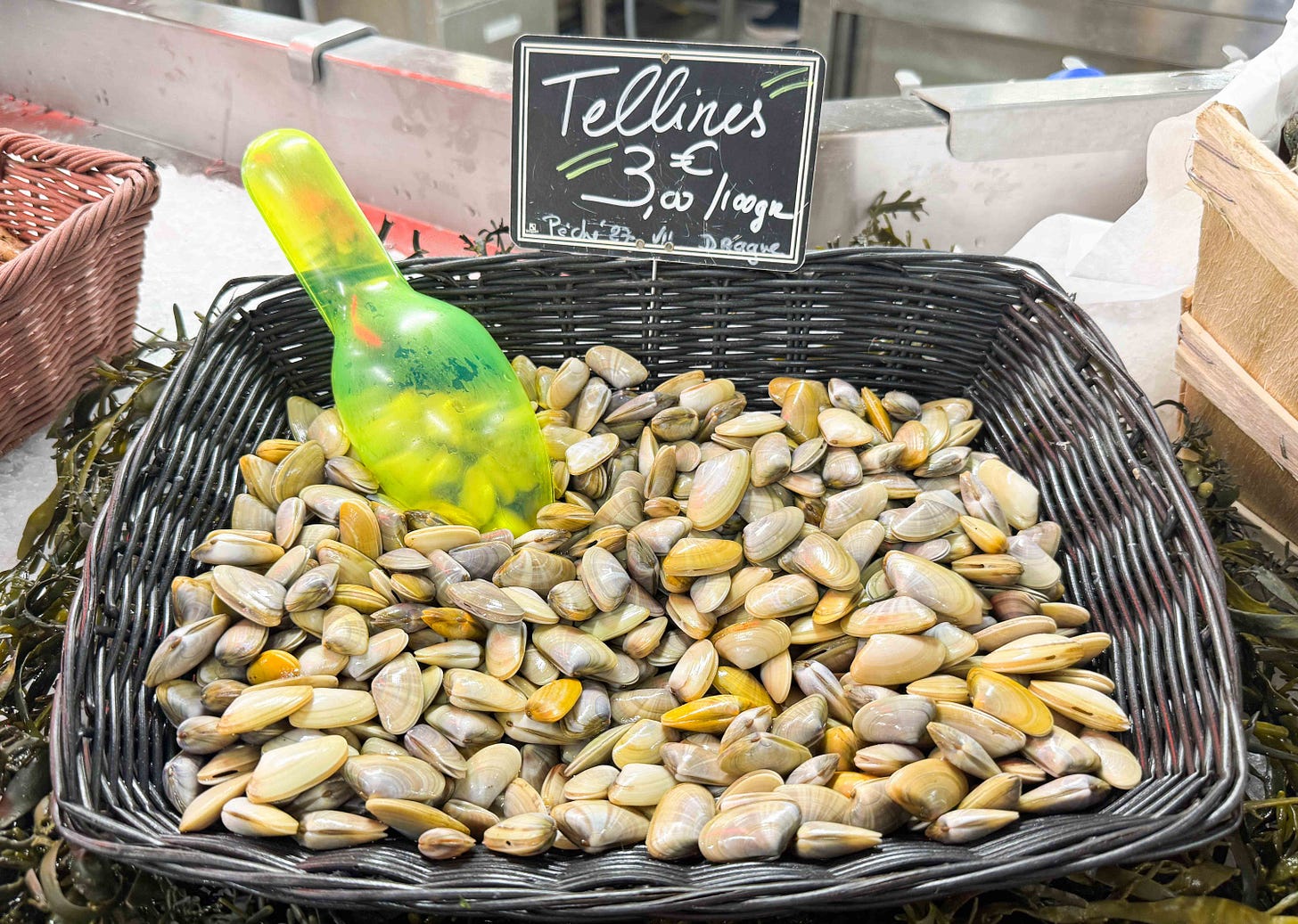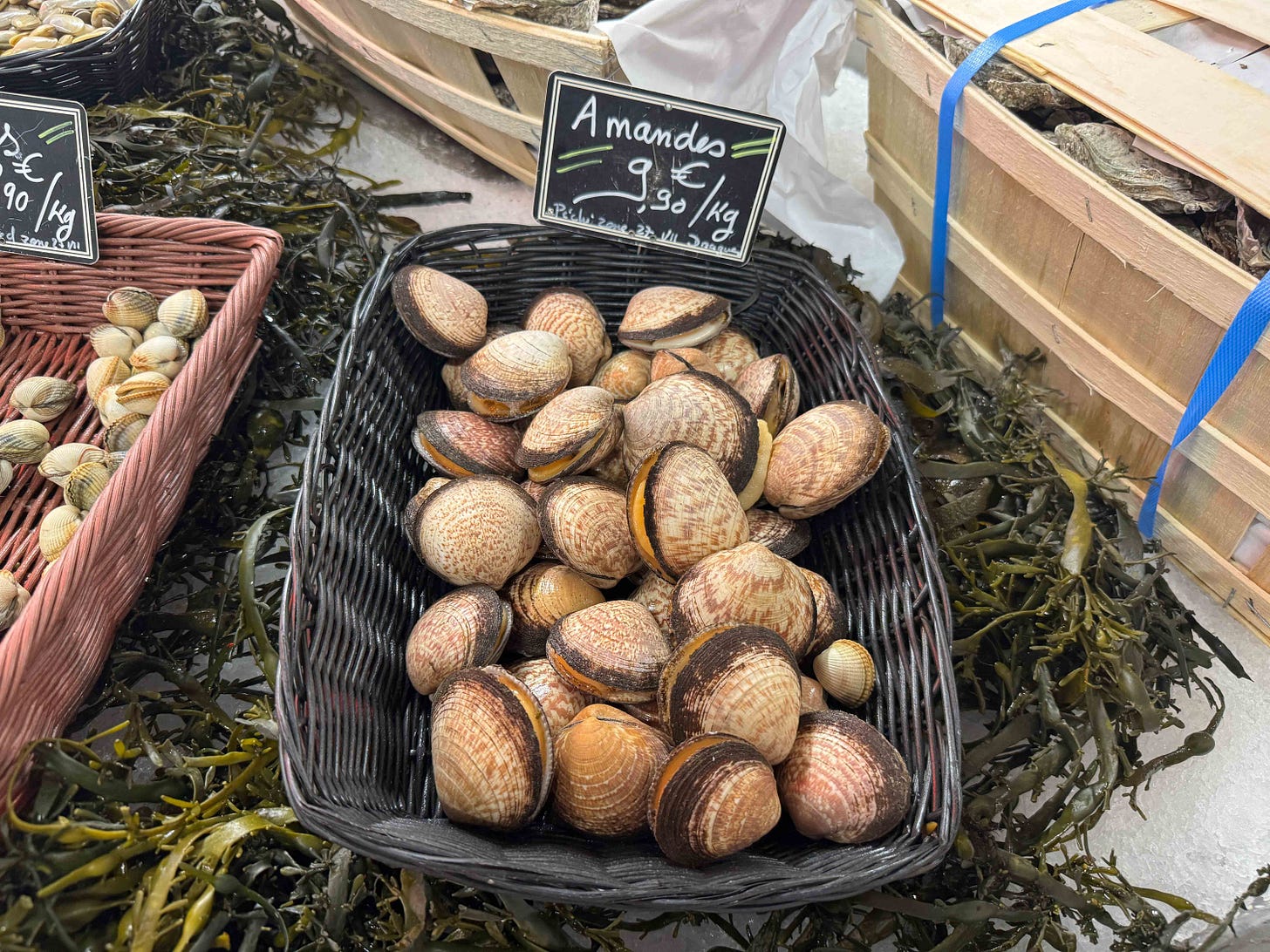Beautiful bivalves of France
A trip to the Marché des Capucins – the urban farmers market known as "the Belly of Bordeaux" – turned up some delightful discoveries. A couple can be replicated chez vous.
Last week, I had the opportunity to visit the Marché des Capucins, the storied 275-year-old covered city market known as “the Belly of Bordeaux.” My husband Thierry — whose grandparents did their weekly shopping there last century — had been there the previous year and wanted me to see it.
What a treat to soak it all in!
It was a treasure-trove of lovely produce, as you’d expect — cherries, artichokes, fresh green almonds, tiny grenailles (new potatoes), generous bunches of vervein (verbena) and chervil. Oh, what I wouldn’t give to have regular access to herbs like those!
There were also impressive displays of olives, charcuterie and cheeses, a well stocked stand of enticing products from Pays Basque (hams, sausages, cheeses, etc.) and a remarkable range of fish, meats and poultry.
What intrigued me most, though, was the array of beautiful bivalves and other sea creatures — including a monkfish who smiled back at us.
I was completely gobsmacked at the sight of a basket filled with tiny clams called tellines — I’d never heard of them. With smooth, shiny shells in shades of lavender and gold, they’re no bigger than fingernails; I’ve definitely seen shells like this on the beach at Lacanau, where Thierry’s family has a house.
Had we been headed directly back there, I’d have certainly scooped up those pretty little tellines. I’ve since read that they’re also called wedge clams or coquina clams, that they’re prized in Provence and they’re incredibly easy to prepare. You just put them in a pan (no liquid or anything else needed), cook till they’re nearly all open, then throw in some butter, minced garlic and chopped parsley, toss it all about a bit, and that’s it. I so wish I could eat that tonight, but I’m back in Dallas, where they do not sell tellines in any market.
Next to the tellines were other lovely bivalves and sea goodies: beautiful golden “amandes” and tiny coques (both raw and still alive), and also baskets of cooked bulots (whelks) and smaller, snail-like bigorneaux.
On our way out just before lunch, we stopped at the market’s oyster bar, which I’d noticed was serving bulots with aïoli — so we stopped for an apéro. That’s what vacation is for, right?!
I’ve had both bulots and bigorneaux served in bistros and wine bars in Paris this way, too — and once years ago in L.A. (I think it was at Gordon Ramsey’s first restaurant there). Last time I had bigorneaux in Paris, they were served with a beautiful green basil aïoli.
Both bigorneaux and bulot are fun to eat: Coax them out of their curvy shells with a long metal pick (you can see one, blurry in the upper left background of the photo above), and dip in the aïoli. Toothpicks serve just as well.
Make boulots or bigorneaux chez vous
Perhaps there are places stateside where you can buy raw bulots or bigorneaux; ten days ago I was in London’s Borough Market, and I didn’t spot them there (nor was I looking for them, though).
However, in the US you can sometimes find whelks or sea snails in Asian supermarkets. If you happen upon them, scoop some up and serve them at home — you’ll find my recipe (for paid subscribers) below.
Naturally, either are delicious with a glass of crisp white wine: At the marché, I chose an Entre-Deux-Mers, while Thierry enjoyed a Ricard (also shown blurrily in the background, before he added the requisite water).
In case you missed it:
RECIPE: Bulots or Bigorneaux à l'Aïoli (Whelks or Sea Snails with Aïoli)
Look for whelks that are about an inch and a half (4 cm) long, not the larger ones, or any small sea snails.
My recipe for aïoli is for a traditional one, with the option of adding finely chopped basil for an herbal twist. You might want to do half basil aïoli and half traditional; if you want only basil aïoli, consider doubling the leaves and tossing them into the blender halfway through the emulsifying process for a smooth, uniform texture and color. You can use either a blender or a food processor for this; with a blender, the aïoli – a garlicky, mayonnaise-like emulsion – is less likely to "break," or have the oil separate out. If you use a food processor, chop the garlic finely in the food processor first before adding the other ingredients, and when you begin to add the oil, be sure to add it very slowly in the beginning. If it does break, don't panic: put a fresh egg yolk in a separate bowl, and slowly whisk in the broken aïoli.
The bulots or bigorneaux may be served warm, cooled to room temp or chilled in the fridge, making them an ideal party bite. They can be a little tricky to eat: remove the hard flap, then use a toothpick to gently coax the meat out of the shell.
FOR THE SEA CREATURES:
Ingredients
1 1/2 to 2 pounds (about 750 grams to a kilo) whelks or sea snails
2 bay leaves
1/2 onion, sliced
5 or 6 thyme sprigs
A splash of white wine
Sea salt
Instructions
Purge the sea creatures of sand: Place them in a bowl, cover with cold water and let them sit 10 minutes. Rinse.
Bring a large pot of water to a boil with the bay leaves, onion, thyme, white wine and a generous amount of sea salt. Add the sea creatures, and if you're going to serve them warm, cook them 20 minutes, adjusting the heat so they're boiling but not clanging around too much. Drain them and serve with aïoli. If you're going to serve them room temp or chilled, cook for 15 minutes, remove the covered pan from the heat and then let them cool in the water. Then drain and serve with the aïoli, or chill.
FOR THE AïOLI:
Ingredients
5 garlic cloves, peeled
1 egg yolk
1 teaspoon Dijon mustard
1 tablespoon freshly squeezed lemon juice (juice of half a medium lemon of average juiciness)
1/2 cup (120 ml) olive oil
Sea salt
1 tablespoon finely chopped basil (about 5 large leaves – optional)
Instructions
Place the garlic in the bowl of a blender with the egg yolk, mustard and lemon juice. Pulse until the garlic is finely chopped and the ingredients are combined.
With the blender running, very slowly pour the oil in a very thin stream until it is all incorporated. Add salt to taste.
If you want to make some of it into basil aïoli, place half the aïoli into a small bowl and stir in the chopped basil.










